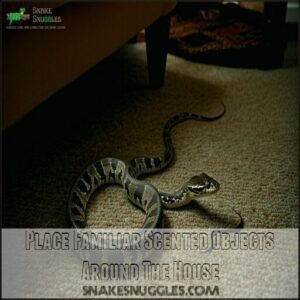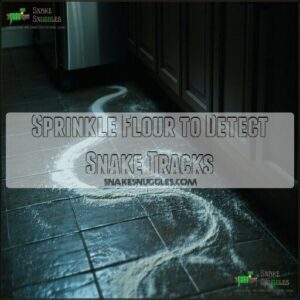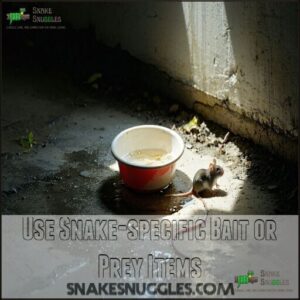This site is supported by our readers. We may earn a commission, at no cost to you, if you purchase through links.
 If your pet snake is missing, don’t panic—it’s likely hiding nearby.
If your pet snake is missing, don’t panic—it’s likely hiding nearby.
Start by securing other pets and family members, then block exits to keep it inside. Snakes love warm, dark, and cozy spots, so check under furniture, in closets, and near heat sources like vents or electronics.
Soft piles of laundry and high shelves are also great hiding places. Set up heat lamps or familiar objects to lure it, and sprinkle flour to spot tracks.
Consider baiting with prey if needed. If it’s still missing, contact local herpetologists or professionals. With patience, you’re bound to outsmart your sneaky escape artist!
Table Of Contents
- Key Takeaways
- Act Fast: Time is Crucial in Snake Searches
- Identify Your Snake’s Favorite Hiding Spots
- Create an Enticing Environment for Your Snake
- Conduct a Systematic Room-by-Room Search
- Seek Professional Help if Necessary
- Frequently Asked Questions (FAQs)
- How do you find a lost pet snake?
- How do you find a missing snake?
- Where do snakes go if you search for a snake?
- Can dogs and cats find lost snakes?
- How do you find a pet snake?
- How do you find a lost snake in a house?
- How Do I Know if My Pet Snake is Missing?
- What Should I Do if I Come Across a Snake That I Think is Lost?
- What is the Best Way to Care for a Pet Snake?
- Are There Any Potential Health Risks to Owning a Pet Snake?
- Conclusion
Key Takeaways
- Check warm, dark, and tight spaces first, like under furniture, near vents, or inside closets.
- Use tools like flashlights, flour traps, or heat lamps to spot movement and lure your snake out.
- Block all exits immediately to keep your snake inside and secure other pets to avoid interference.
- If your efforts fail, contact local herpetologists or professional snake catchers for expert help.
Act Fast: Time is Crucial in Snake Searches
Acting quickly is essential to prevent your snake from wandering too far or finding unsafe hiding spots.
Act fast to keep your snake safe—quick action prevents escapes and avoids dangerous hiding spots.
Start searching immediately, focusing first on securing other pets and closing off escape routes, to ensure a safe environment.
Secure Other Pets and Family Members
It’s essential to focus on family safety and pet containment to keep everyone safe when your snake goes missing.
Begin by isolating dogs and cats in secure rooms or kennels and childproofing your home by supervising kids closely.
Inform family members calmly and explain the situation to reduce stress.
Initiate a household lockdown by closing doors to unnecessary spaces and limiting movement.
- Isolate all pets to prevent harm or interference.
- Supervise interactions between children and pets until the snake is recovered.
- Snakeproof your surroundings to guarantee safety.
Close Off Potential Escape Routes
To stop your snake from venturing too far, focus on snake escape prevention by sealing every possible exit.
Close doors and windows immediately and inspect for any gaps—secure them with rolled towels or draft stoppers. Pay close attention to vents and cover them with fine mesh to block climbing escapes.
If there are cracks in walls, floors, or ceilings, patch them with caulk or sealant right away. Don’t forget overlooked spots like pipes or drains—cover these openings with sturdy barriers.
Strengthen your snake tank security by ensuring the lid is firmly latched. A tightly secured area keeps your snake safe and helps you focus your search without worrying about it sneaking off further, which is crucial for effective escape prevention and maintaining a secure environment for your snake to prevent it from getting into overlooked spots.
Begin Search Immediately After Noticing Absence
Once you notice your snake is gone, it’s time for Early Action and a Quick Response. Snakes are escape artists, and a lot can happen in a short time. Start in the immediate area. Focus on snake hiding spots that provide warmth or security, as these align with natural snake behavior.
Early action is key—snakes are escape artists, so search nearby warm and secure spots to outsmart their stealthy hiding instincts.
Move methodically through your home to maximize the search area:
- Search warm places, like heaters, vents, or behind electronics.
- Check tight spots, including under furniture and inside small gaps.
- Use tools like flashlights or mirrors to explore dark spaces.
- Look for subtle clues, such as rustling sounds or shifted objects.
- Secure perimeters by closing doors to limit movement.
Careful searches early can save hours later. Remember that excessive handling causes stress and avoid startling the snake if found.
Identify Your Snake’s Favorite Hiding Spots
Your snake is likely hiding somewhere that feels secure, warm, or dark.
Focus on checking spots like heating vents, cozy piles of laundry, or enclosed spaces such as drawers and closets.
Warm Areas Like Heating Vents or Electronics
Snakes are drawn to warm spots, so start your search near heating vents, appliances, and electronics. These snake hiding spots offer consistent heat that reptiles love.
Carefully check inside vents with a flashlight—snakes can slither into tight spaces. Look behind refrigerators or water heaters, where appliance warmth gathers, and inspect cords or baseboards for tucked-away pets.
Electronics also radiate heat, so peek around TVs or computers. Feel for heat sources with your hand and use mirrors for hard-to-see areas.
Snakes may hide to regulate body temperature, seeking comfortable microclimates. Remember, overheating risks could harm your snake, so act quickly and inspect these cozy spots with a clear snake search strategy.
Dark, Enclosed Spaces Such as Closets or Drawers
Dark, enclosed spots like closets or drawers are prime snake hiding places. They love tight spaces offering safety and warmth.
Use methodical checks to inspect these areas:
- Peek behind hanging clothes in closets.
- Pull drawers fully out, feeling beneath contents for movement.
- Search inside folded linens or towels stored in cabinets.
- Open shoeboxes or storage bins—they’re irresistible for snakes due to their snug, dark corners, which provide safety and warmth and are often found in tight spaces.
Soft, Cozy Spots Like Piles of Laundry
Laundry piles often offer the perfect combination of warmth and security for your snake.
Carefully inspect clothing piles, hampers, and bedding where they might curl up. Gently shake out blankets and check fabric folds—your snake could be nestled in these cozy, hidden spots.
Don’t ignore stuffed animals or plush pillows, as their texture mimics natural hiding places. Even drawers packed with soft socks can provide snug hiding spots.
Be mindful of detergent smells, which might initially attract your snake to these locations. Systematically search each area without rushing to guarantee thoroughness.
These warm spots are instinctively comforting for your pet, and it’s essential to check them carefully to ensure your snake’s safety and security.
High Places Like Bookshelves or Curtain Rods
Never underestimate your snake’s climbing ability—it might be perched in high places like bookshelves or curtain rods.
Look for subtle signs of movement or odd placements on top of furniture.
- Check curtain rods, shelf edges, and lighting fixtures for any areas the snake may curl around.
Ensure the rod stability and check for fall risks while searching.
Use a flashlight or selfie stick to carefully inspect hidden spots.
Snakes often prefer secure, elevated corners for resting and hiding.
Create an Enticing Environment for Your Snake
To lure your missing snake out of hiding, create a warm, appealing environment that mimics its natural preferences.
Use familiar scents, heat sources, and carefully placed bait to encourage it to emerge.
Set Up Heat Lamps in Strategic Locations
Warmth is irresistible to snakes, so heat lamps can be your best helpers in coaxing your pet out.
- Optimal Placement: Position heat lamps near potential snake hiding locations, like under cabinets or behind sofas.
- Temperature Gradient: Adjust the height and wattage to create a comfortable basking zone that matches your snake’s temperature preferences.
- Safety Precautions: Use energy-efficient bulbs and secure lamps to avoid accidents.
You can find the right heat lamp for your snake online.
By mimicking the cozy warmth snakes naturally seek, these heat sources become the perfect bait. Keep an eye on those spots—you might just spot your snake basking back to safety!
Place Familiar Scented Objects Around The House
Snakes rely heavily on their sense of smell, so familiar scents can act as olfactory guidance in bringing them out of hiding.
Place items like their hide, used bedding, or even a worn T-shirt near likely hiding spots. These objects provide reassurance signals and create comforting scent familiarity for your snake.
They might associate these scents with safety, reducing stress and encouraging emergence.
Here’s a quick guide:
| Item | Purpose | Placement |
|---|---|---|
| Snake’s hide | Snake comfort | Warm, dark corners |
| Used bedding | Scent familiarity | Along walls or under furniture |
| Worn clothing | Reassurance signals | Near pathways or small spaces |
Patience is key—let their behavior guide your snake search!
Sprinkle Flour to Detect Snake Tracks
Flour traps are a clever tool for tracking a lost snake within your home. By capturing subtle movements, they can point you toward hiding spots.
Here’s a step-by-step guide to making the most of this method:
- Choose strategic locations like doorways, along baseboards, or near warm appliances for trap placement.
- Spread a thin, even layer of flour—choose fine flour types, like all-purpose, for better clarity during footprint analysis.
- Inspect for snake tracks, such as smooth, wavy lines caused by its body dragging through the powder.
- Adapt to environmental factors, like avoiding areas with strong airflow, which could disturb your setup.
Flour tracking offers a simple, effective way to detect snake movement!
Use Snake-specific Bait or Prey Items
Sometimes the best way to lure your snake out is with food bait. Thawed rodents or scented lures can be incredibly effective when placed in areas your snake might explore, like warm spots or dark hiding spaces.
Live prey? It’s an option, but consider ethical concerns and keep other pets secured. Add water dishes nearby or snake-specific bait like snake food or snake mice to enhance the setup.
You can find various options for reptile food products online.
Here’s a handy table for bait placement tips:
Bait Type Best Location Frequency to Check
Patience is key—your snake values safety and timing.
Conduct a Systematic Room-by-Room Search
Begin your search in the room where your snake was last seen, checking every nook and cranny thoroughly.
Take your time to move furniture, inspect tight spaces, and look behind appliances to guarantee no hiding spot is missed.
Start in The Room Where Snake Was Last Seen
Start your initial search in the room where the snake was last seen. Snakes often don’t stray far, especially if hiding spots are nearby.
Use a flashlight to inspect behind the tank, under cushions, and in vents or cracks. Focus on the floor, as snakes usually stay low. Be systematic and patient—don’t skip corners or tight spaces.
- Think small: Look into gaps a coin could fit through.
- Floor focus: Check baseboards and hidden areas.
- Listen carefully: Pause occasionally to hear faint movements.
Move Furniture and Inspect Tight Spaces
Your snake’s favorite hiding places might be right under your nose—literally.
Carefully move furniture like sofas, tables, and shelves, checking for signs of life underneath furniture or behind objects.
Use a flashlight to peek into tight spaces, small gaps, or inside couches where warmth and darkness feel safe to them.
Baseboards and rugs often have secret nooks snakes enjoy.
Take time to thoroughly inspect these areas with caution, as snakes love sneaky spots. Don’t forget to check closets and carefully explore less obvious, snug hiding places nearby, where they can find secret nooks and feel safe.
Check Inside Appliances and Electronics
Appliances and electronics are often irresistible hiding places for snakes due to their warmth and small spaces.
Always unplug items first to guarantee component safety.
Inspect carefully:
- Major appliances: Look behind and underneath your refrigerator, oven, and washer, as warm spots attract snake hiding behavior.
- Electronics with vents: Check gaming consoles, computers, and other smaller devices.
- Out-of-sight nooks: Search tight gaps or openings beneath appliances like dishwashers or dryers.
Use a flashlight to explore hidden places and guarantee your snake hasn’t tangled with cords or slipped into internal components.
Explore Outdoor Areas if Applicable
During your snake outdoor search, prioritize outdoor hiding spots like shaded areas, mulch piles, and fence gaps.
Perform a careful snake garden check, inspecting bushes, patio cracks, and vehicle wheel wells. Expand to a snake outbuilding inspection, checking sheds and garages—perfect hiding spots.
Look for clues like shed skin or tracks, and verify escape routes with a snake perimeter scan. Remember that yards often provide shelter and food for snakes.
Seek Professional Help if Necessary
If you’ve tried everything and still can’t locate your snake, it’s time to call in the experts.
Professional snake catchers, herpetological societies, or reptile veterinarians have the tools and knowledge to help find and safely recover your pet.
Contact Local Herpetological Societies
If you’ve checked every nook and cranny and still can’t find your snake, it’s time to reach out to local herpetological societies.
These groups are full of experts who understand snake behavior and can offer targeted advice for your situation.
Here’s how they can help:
- Local experts with specialized equipment can track down hard-to-find snakes, even in tricky spots like walls or vents.
- Snake rescue teams familiar with your area know escape patterns based on climate and housing.
- Community support networks can spread the word and alert neighbors to keep an eye out.
They can also offer species-specific advice, helping you predict hiding spots.
Regular checkups are key for early disease detection.
Most services are free or low-cost, making them an ideal option.
Hire a Professional Snake Catcher
If your snake’s still MIA after your best efforts, it might be time to call in the pros. Expert snake removal specialists have the training and tools to handle tricky recoveries safely and efficiently.
With thermal cameras, snake hooks, and years of experience, they can locate and capture your pet without harm. Professional consultation costs usually range between $75 and $200, depending on your location.
Most snake removal experts respond within 24 hours, and their success rate for indoor escapes is impressively high—around 80-95%. When searching, look up “local reptile experts” or “snake removal expert” in your area.
Peace of mind is well worth the snake catcher fees, especially when this guarantees your pet’s safe return.
Consult With Experienced Reptile Veterinarians
Reptile veterinarians bring expert insight when your pet snake goes missing and nothing else works.
Their species knowledge and experience help you understand your snake’s habits and needs.
Here’s how they assist:
- Customized Search Tips: Personalized advice based on your snake’s behavior, age, and health.
- Handling Guidance: Safe techniques for retrieval when you find your snake.
- Health Concerns: Insight into issues caused by time away from its habitat.
- Snake Rescue Contacts: Access to emergency snake experts for immediate help.
- Preventative Measures: Tips to avoid future escapes and protect your snake.
Veterinarians are your go-to resource for professional snake advice and effective search support.
Utilize Specialized Snake-finding Equipment
When traditional methods like snake hooks and flour traps come up short, advanced snake detection tools can save the day.
Thermal imaging cameras are excellent for spotting your snake’s body heat against cooler surroundings, while borescopes help you explore tight corners and hidden areas without tearing apart your home.
For nighttime searches, snake thermal cameras or night vision gear are great allies.
Acoustic monitors or motion sensors can pinpoint movement if your snake is active, and some reptile clubs even rent professional snake detection technologies to help you avoid steep costs.
If you’re tracking your snake’s path, sprinkle flour or cornstarch for an affordable solution, and remember that these tools, combined with patience and a systematic approach, increase your chances of finding your pet quickly.
Frequently Asked Questions (FAQs)
How do you find a lost pet snake?
Start in the room where the snake was last seen.
Check tight spaces, warm areas, and floor-level hiding spots.
Use flashlights, flour traps, and noise traps.
Stay calm, block exits, and search methodically.
How do you find a missing snake?
Losing a snake can feel like finding a needle in a haystack, but start low—check under furniture, near warm spots like appliances, and inside tight spaces.
Use heat traps, flour trails, and stay patient.
Where do snakes go if you search for a snake?
Snakes often head to dark, tight spaces like under furniture, inside cabinets, or beneath appliances.
They’re drawn to warmth, so check near heaters, vents, or sunlight.
Think small, hidden, and cozy when searching.
Can dogs and cats find lost snakes?
Curious cats and diligent dogs can detect hidden snakes with their sharp senses of smell and hearing.
While their instincts might guide them to the snake, watch closely to guarantee no harm comes to either.
How do you find a pet snake?
Search low and scan shadowy, tight spots like under furniture, appliances, and cracks.
Use a flashlight and mirrors for hidden areas.
Calmly lure them with warm hides, familiar scents, and food, especially at night.
How do you find a lost snake in a house?
Imagine your house as a maze.
Start where the snake vanished, checking warm, tight spaces—under furniture, inside vents, behind appliances.
Use flashlights, flour traps, or a heat source to lure it safely back.
How Do I Know if My Pet Snake is Missing?
You’ll notice your snake is missing if it’s not in its enclosure despite a secure lid.
Check every hide, decoration, or crease.
Escape signs include open lids, gaps, or damaged tank seals.
What Should I Do if I Come Across a Snake That I Think is Lost?
Over 60% of missing snakes stay close to their tanks.
If you spot a wandering snake, stay calm, keep pets away, and contact local animal control or nearby pet owners for guidance and safety.
What is the Best Way to Care for a Pet Snake?
Provide your snake a secure enclosure with proper heating, humidity, and hiding spots.
Feed them species-appropriate prey. Handle them gently to reduce stress.
Regularly clean their habitat, and make certain fresh water is always available.
Are There Any Potential Health Risks to Owning a Pet Snake?
Owning a pet snake feels like discovering a world of wonder.
But remember: snakes can carry salmonella or parasites.
Wash your hands after handling and maintain clean enclosures to prevent any potential health risks.
Conclusion
Tracking down your snake might seem like finding a needle in a haystack, but with patience and strategic steps, you’ll likely succeed.
Remember, snakes aren’t time travelers—they stick close to home, often hiding in warm, dark, or high spots.
Use tools like heat lamps, flour, or bait, and search systematically. If nothing works, reach out to experts for guidance.
By staying calm and methodical, you’ll master how to find a missing pet snake and reunite safely.

















